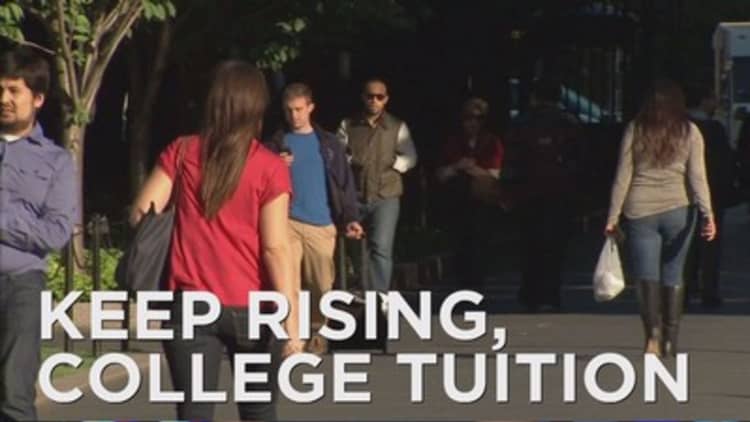Financial advisor Howard Pressman has two clients, a married couple, whose son is in his last year of college. The 529 college savings plan they set up when their son was a child has almost entirely funded his higher education.
They planned well, Pressman explained.
Pressman said if the money had been kept in an age-based portfolio within that 529 plan, they might have fallen far short of that goal. That's because the portfolio became too conservative even when the son was still years away from using the money.
"Given all that was happening with the economy, it made sense to be more aggressive," said Pressman, a certified financial planner with Egan, Berger & Weiner.
Instead of leaving the money in the age-based option once the child entered his teenage years, Pressman created a portfolio that kept most of the money invested in stocks.
Read MoreKeep an eye on your 529 plan
"It worked out well," he said. "We came really, really close to completely funding his college expenses."
529 college savings plans, named for the section of the federal tax code that created them, give parents a tax-advantaged way to sock away money for their children's college expenses.

Earnings and interest on the money grows tax-free, although contributions are not tax-deductible on federal tax returns. (Some plans allow deductions at the state level.) Distributions are also tax-exempt as long as the beneficiary uses the money for college-related expenses, such as tuition, books and room and board.
Data from the College Savings Plan Network show there are roughly 12 million 529 accounts, with an aggregate value of $250 billion. The average account size is about $21,000.
Given the high cost of college, it's no wonder parents are taking advantage of 529 plans.
According to College Board, the average yearly cost for tuition and fees at a public college for in-state residents is $9,139. For out-of-state residents, that average cost jumps to $22,958. Private universities average $31,231 annually. And those amounts don't even include things such as housing, food and textbooks.
Age-based portfolios in 529 plans basically work like this: You pick a portfolio based on your child's age or the year he or she will need the money—say, 2030—and the portfolio automatically moves gradually to less risky investments the closer it gets to that year.
Read MoreHow to refinance that student loan
But, say some financial advisors, those portfolios are too cookie-cutter and become too conservative at preset times regardless of what's happening with the economy or the stock market. Some plans adjust holdings fairly regularly, while others do it at specific age-based intervals.
"There are kids in elementary school whose 529 [age-based] accounts have bonds in them," said Dick Power, a CFP and the principal of Power Plans. "That's crazy."
Financial advisors often can access a broader variety of options through a 529 plan than parents can. Pressman, for instance, could choose from a couple dozen mutual funds through the state of Virginia's plan. That enabled him to create a portfolio for his clients that kept the money mostly in stocks to capitalize on market gains instead of languishing in bonds and/or cash.
"It's a one-dimensional decision process with age-based portfolios," Pressman said. "I don't think anything as complicated as this should be boiled down to one particular factor like [a child's] age."
For anyone who wants to control the investment mix in a 529 plan, there are ways to do it even if you do not work with a financial advisor.
For instance, you can open more than one 529 plan for a child. That alone can give you exposure to more than one investment manager's expertise and performance. Each state contracts with investment companies to manage the offerings within its 529 plan.
Joe Hurley, founder of website Savingforcollege.com, said that if you do choose to open more than one 529 account for a single beneficiary, two should be the limit.
At one point, as part of his research, Hurley had 33 plans open for his two children. "It's too much paperwork," he said. "There's really no benefit to having more than two, if that."
Read MoreWhen to cut off your adult kids
Also, most 529 plans offer static portfolios, meaning that the allocation in them does not change. If it's an aggressive portfolio, it will be in all stocks or mostly stocks. If it's a conservative one, it will be all or mostly in bonds and cash. A moderate portfolio will include a mix of the above.
But be aware that changes to a 529 account can only be made twice a year. That means you cannot suddenly react to market conditions on a frequent basis, which any financial advisor would say is unwise, anyway.
Power at Power Plans said that depending on the client's financial situation, he might recommend a static aggressive portfolio that probably has no bonds and just a little bit of cash.
"I might say, though, that if the [stock] market is looking soft, let's switch to an age-based portfolio," Power said. "It really depends on what's happening with the market and what the client's needs are."
If I have a client who's not terribly well off, I'll probably have them stick with an age-based plan because they can't afford to take too many chances.Dick Powerprincipal of Power Plans
He explained that if a client's income and assets are relatively high, he's inclined to be more aggressive because the client is better able pick up some of the child's college costs if the market is down.
"If I have a client who's not terribly well off, I'll probably have them stick with an age-based plan because they can't afford to take too many chances," Power said. "They don't have the financial flexibility to make up the difference."
However, he added, "unless you have enough time to pay attention to it, just go with the age-based portfolio. For the ordinary person, they are still a good choice."
—By Sarah O'Brien, special to CNBC.com




